This feature was published in Issue 5 of Notebook magazine as part of a broader exploration of the instructional form. The magazine is available via direct subscription or in select stores around the world.

Lupino Lane’s acrobatic slapstick, saucer-eyed charm and comic timing made him a sensation in the music halls of his native London and on cinema screens around the world. He guaranteed his place in pop culture posterity when he first presented the sharp-elbowed strolling dance, “The Lambeth Walk,” in the 1937 hit West End musical Me and My Girl. Lane also starred in Albert de Courville’s film adaptation The Lambeth Walk in 1939, which transformed the cockney jig into a global craze. Lane was born in 1892 into the Lupino theatrical dynasty, which traced its on-stage activities back to the seventeenth century and would soon swell to include his young cousin Ida Lupino, who followed him to Hollywood. Under the moniker “Little Nipper,” Lane made his first stage appearance at the age of four and performed right up until his death in 1959. A master of physical comedy, and a stalwart of pantomime, he was renowned for his prowess when it came to bouncing out of “star traps,” which catapulted him up into the air, pinging between several of the contraptions in a matter of minutes.
The Mass Observation Archive, a social research project that aimed to record everyday life in Britain, devoted a whole chapter to the Lambeth Walk phenomenon, describing Lane as “an alert little cockney, on his toes the whole time like a boxer, with the same suggestion of popular prestige and sportiness.” His appearances on film—both in British silents and several two-reel comedies made in America in the 1920s, often spoofing hit movies—demonstrate his uncanny ability to flip and flop at will, and even spin on his head. His limbs appear elastic, but in reality it took a lifetime of training to fall so hard, so often, and so well. He worked with some of American cinema’s biggest names, including D. W. Griffith for Isn’t Life Wonderful (1924), and his Hollywood peak arrived with his role in Ernst Lubitsch’s musical The Love Parade (1929)—his ribald number “Let’s Be Common” is a joy from start to finish—but he returned to Britain for the rest of his career.
In 1945, a wealthy man thanks to the Lambeth Walk, Lane took it upon himself to salvage some of the music-hall culture that had fallen by the wayside due to the emerging dominance of cinema. He put his own money into a sadly doomed attempt to save the bomb-damaged Gaiety Theatre in Aldwych, London. This was also the point at which he chose to share the wit and wisdom of a lifetime spent making people laugh. His 1945 instructional book How to Become a Comedian—of which Chapter IV, “Funny Falls”, is extracted and reproduced here—garlanded with pratfall diagrams and jolly showbiz anecdotes, provides a chuckle on every page.
—Pamela Hutchinson

Any time you appear to hurt yourself, the audience will always laugh… but it must be through apparent carelessness, mishap, absent-mindedness or misadventure. Remember, the “business” that makes the fall funny also makes it dangerous, for the fall must give the appearance of hurting the performer. This requires practice.
[…]
You must learn to avoid the jar that affects the nervous system and organs which are in line and through which the jar is transmitted. When a man expects to fall upon his feet he will instinctively bend the knees and hips at the moment of impact, and very little of the jar reaches the body. It is advisable to practice the following falls on a soft mat, until you have gained the skill and knack of the timing. Falls are like everything else in comedy—a question of timing and rhythm; if a fall is badly timed, it can be very painful and does not get the desired effect.
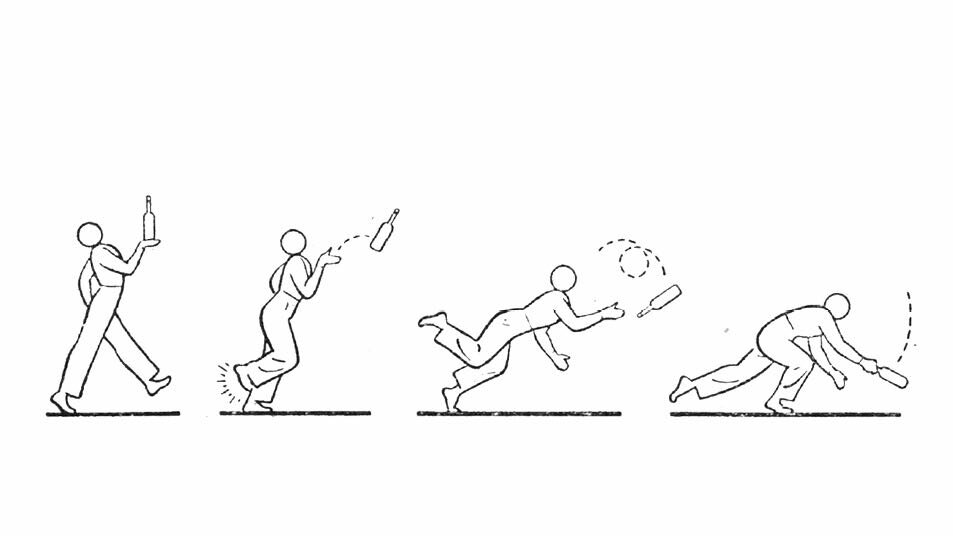
FIRST, let us take the TRIP or STUMBLE. This is done by catching the toe of one foot behind the heel of the other, and tripping forward; you can use this to lose your hat and to step on it accidentally or whilst carrying a tray with plates, etc. The audience will always enjoy anticipating the destruction of such-like articles. If, however, the articles have been fixed to the tray, and you disappoint the anticipation, it is still good for a laugh. The TRIP can be used to bump into someone else, thereby causing them to fall.
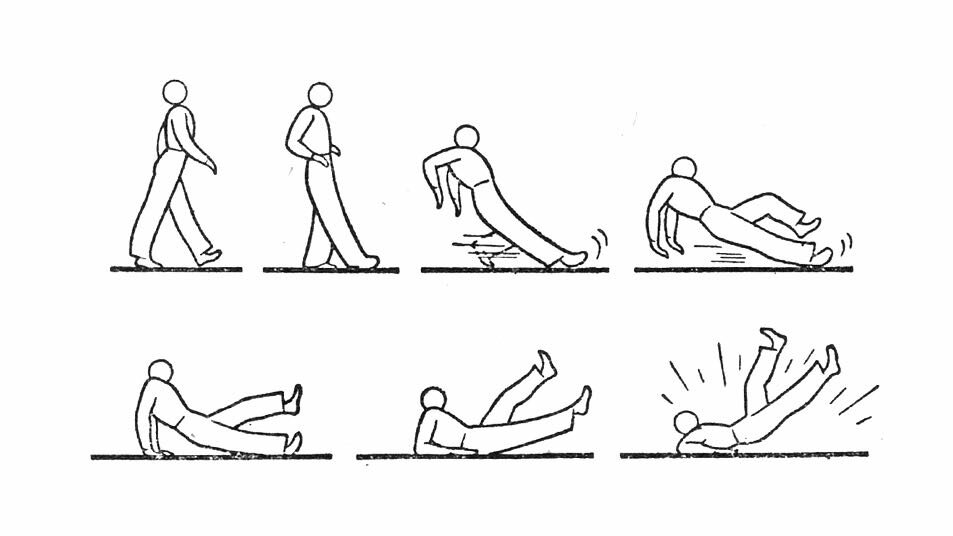
Next we have the SLIDE or SLIP. This conveys the “slipping on a banana skin” movement. You step forward, turning your foot slightly over so that the outside will slide and can be pushed out in front along the floor, relieving the weight of the body by the other leg. You fall on your back, again taking the force of the impact with your hands, forearms, and shoulders; here again, remember to keep your head well forward so that you do not injure the back of your head.
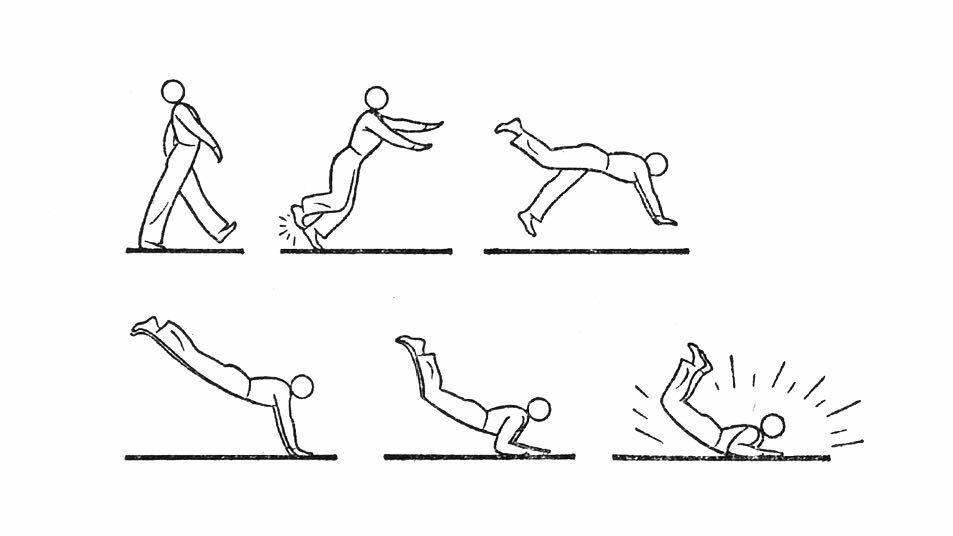
The TRIP can be the cause of the performer appearing to fall on his face. This is done by tripping forward, and at the moment of losing balance, throwing the body forward, being careful to avoid banging your knees, and taking the full force of the impact with the floor on your hands and forearms. Be careful to keep your head sideways, and knees straight. Any knock-about performer will tell you that the knees and elbows seem to be parts of the body which most often get hurt in funny falls. I have had some very painful elbow and knee injuries. Members of my family usually describe any injury of this kind as “a laugh.” One never goes into the dressing room and says, “Look at this bad bruise”; one shows the injury and says, “Look at this big laugh I got tonight”—or, looking at someone else’s hurt, “You’ve got a lovely laugh on your elbow!”
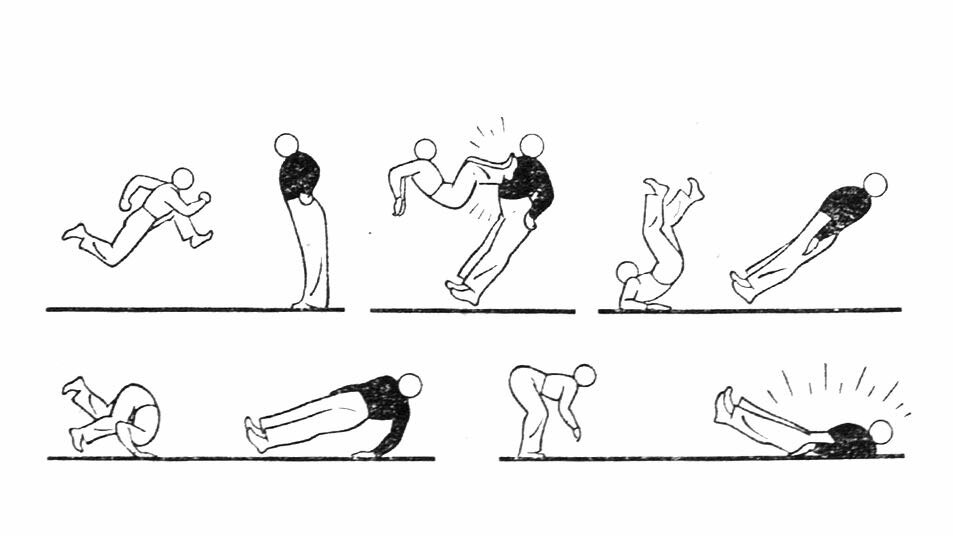
The DEAD BACK FALL is done to express great astonishment, or mental shock. This is rather difficult. The performer falls straight back (keeping the body rigid) from a standing position—the jar to the body is lessened by falling slightly on one side and hitting the floor with the hand on impact.
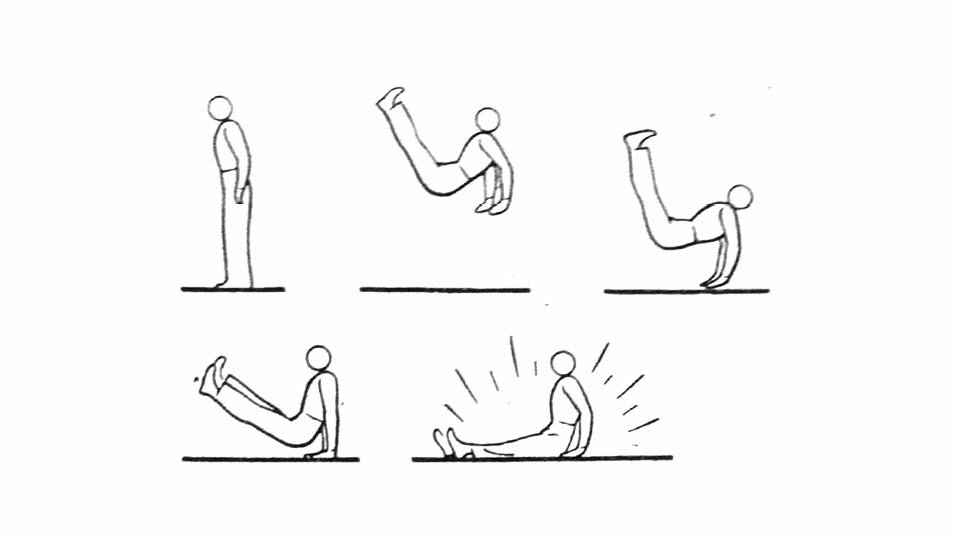
Another dangerous fall is the THROW-BACK. The body is thrown up forward, the arms and hands reaching the floor first, taking the weight of the body and letting it down into a sitting position. Charlie Chaplin is an expert at this.
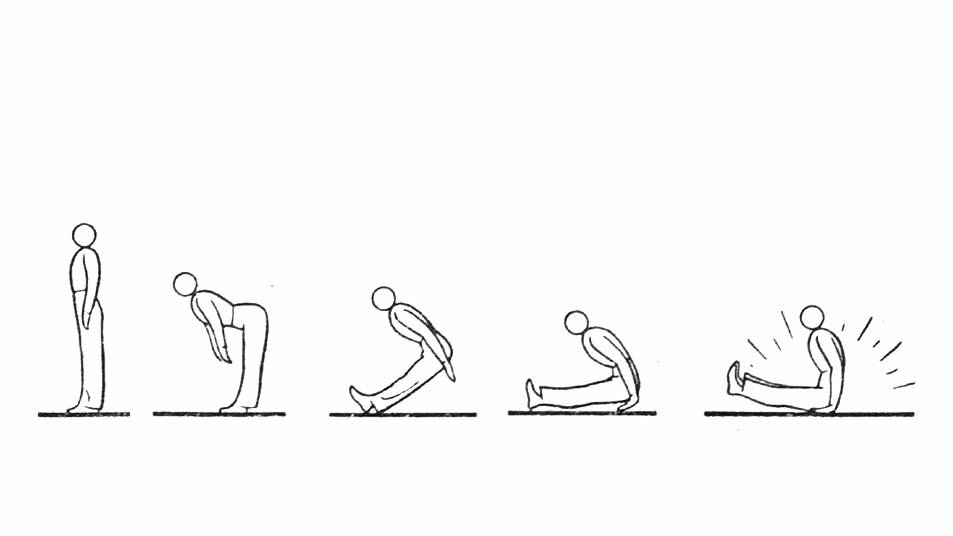
With the SURPRISE FALL you have to be careful to avoid hurting the pelvis. To perform this fall, you keep your legs stiff, bending from the waist into an L shape, but again taking the jar on your arms and hands, which should touch the floor first. This is a simple one for any long-armed person.
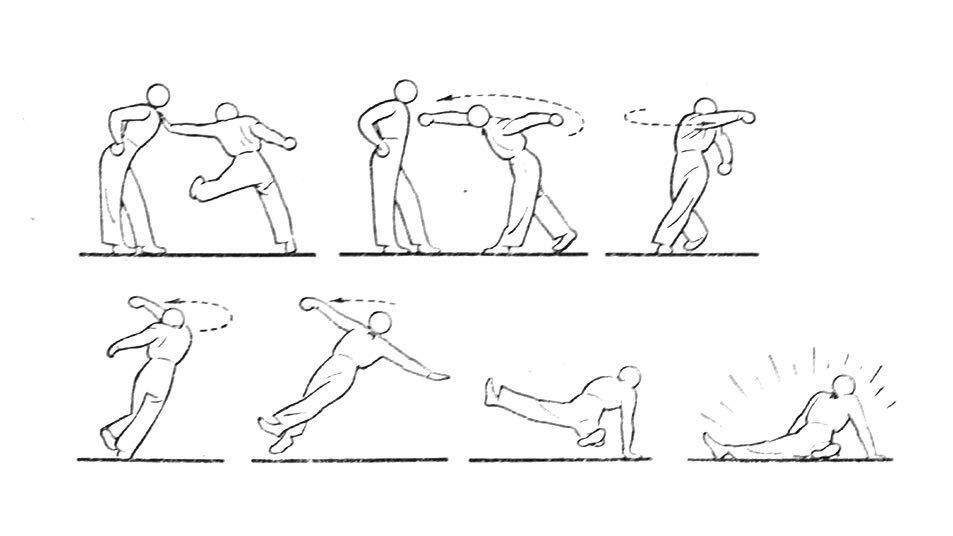
The PIROUETTE FALL is the act of making a swinging blow at somebody and missing, while the momentum turns your body round, making you lose balance and fall flat on your back. This is a difficult one to time.
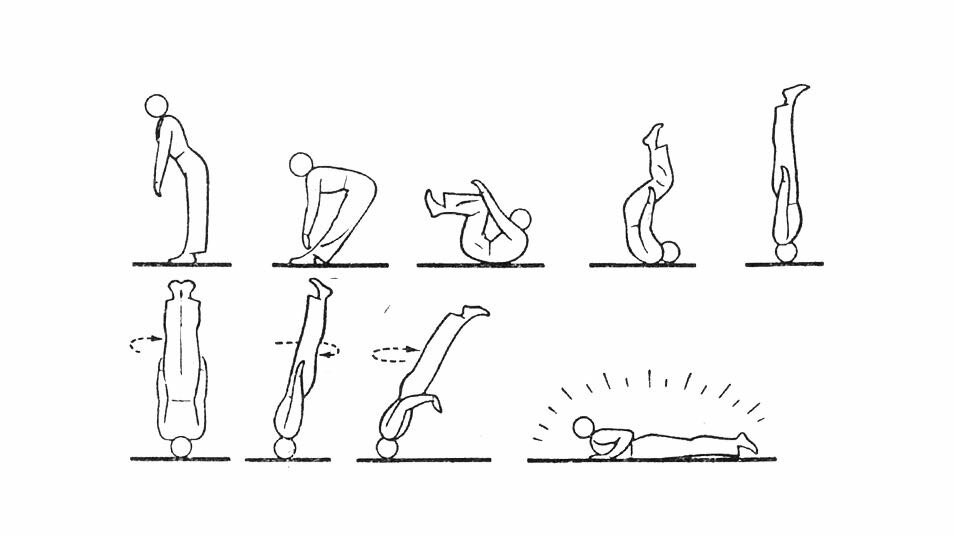
SPIN ON THE HEAD is managed by the performer falling straight back up onto the head and on reaching the floor, pushing with one shoulder to give the body a twist. It is advisable to practice this wearing a padded cap.
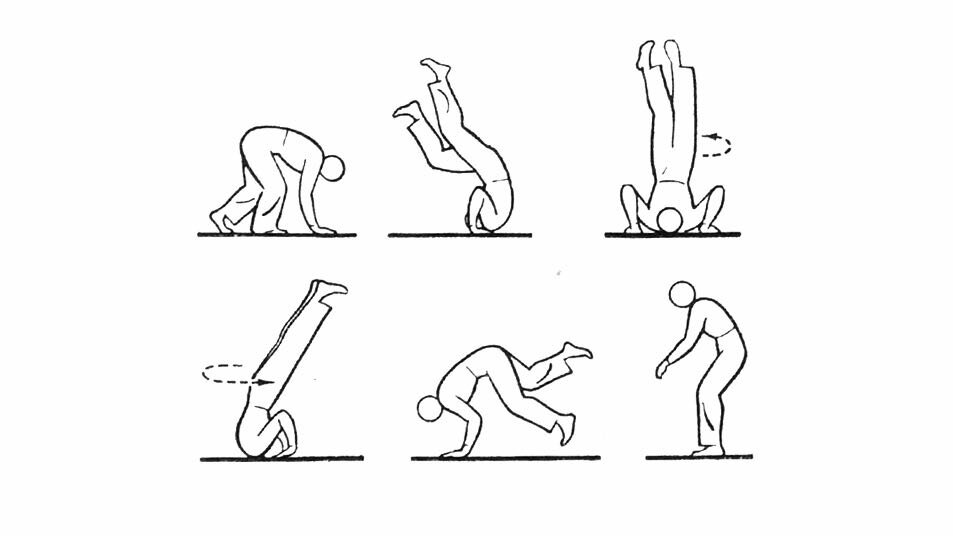
TWIST ROUND THE NECK is done by bending forward onto your hands, then onto your shoulder and, with your hands, giving your body a turn with your legs up in the air.
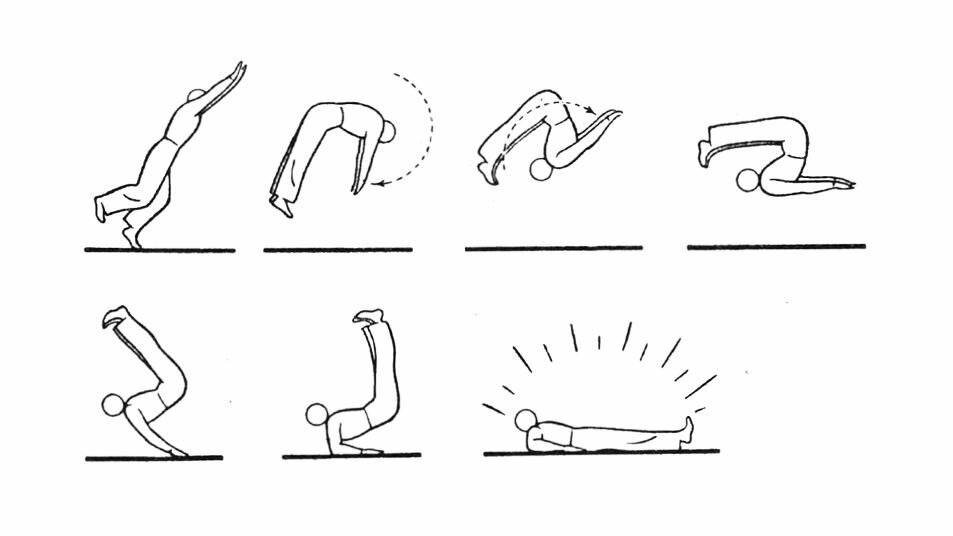
There’s the “108” FALL. This is the daddy of the lot and one of the most dangerous; very few can do this, for it is really an acrobatic trick-cum-fall. It begins with the TRIP, but with the elaboration of the body being thrown up in the air, turning half a forward somersault over the head, and landing flat on the back (see illustration).
[…]
I have used this fall after pretending to miss the last six steps of the stairs. The invention came quite by accident; I was late for an entrance one night and, in my excitement, I tripped at the top of the stairs, missed the lot, and my body turned right over and I landed flat on my back. Needless to say, I was badly winded, nearly knocked right out, and hurt my back badly, but it got such a big laugh from the audience that I practiced the fall until I had command of it.
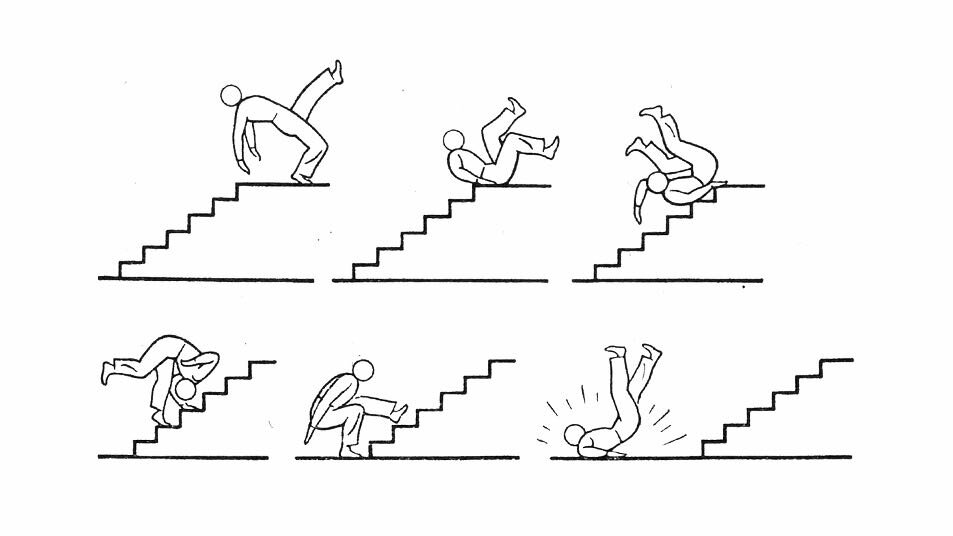
FALLING DOWNSTAIRS. There are many ways of doing this, but avoid trying to do so down narrow ones—they should be at least six feet wide. The easiest method is to fall full length at the top and roll down to the bottom. Do not attempt to go down head first. I have found out, after a great deal of experience, that the most effective way is to get to the top of the stairs and fall down backwards, so that the head and shoulders from the waist upwards are over the top step, then turn backwards over the head and hope for the best!
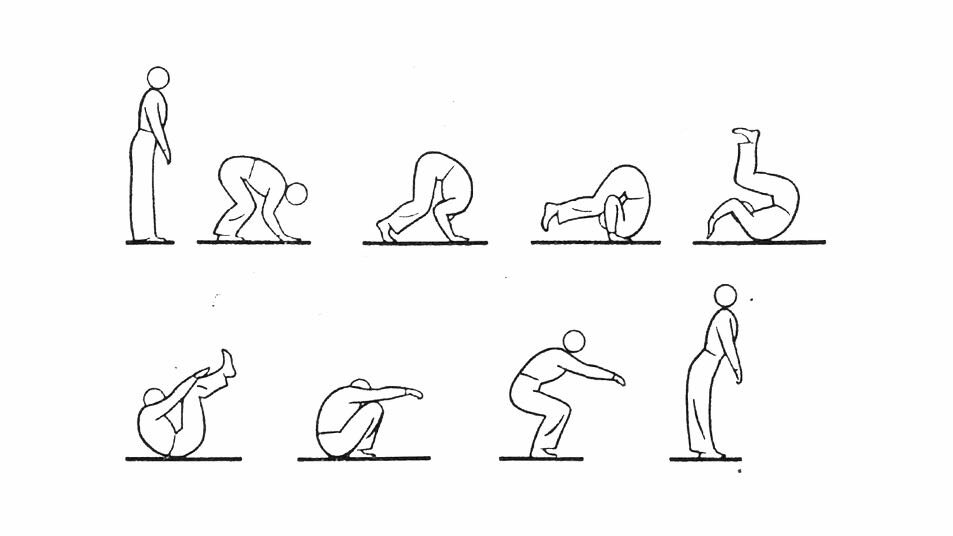
My advice to the beginner is first to learn to be able to do the ordinary ROLL OVER THE HEAD onto the feet. This will give you control for all forward falls. It is done by putting the hands in front of you onto the floor, close to the feet, keeping your head tucked in, pushing the body by the feet over onto the shoulders, then bringing the heels as close as possible to the base of the body, catching the shins with the hands and pulling the body to an erect position. Then practice the ROLL BACKWARDS by reversing the instructions (see illustrations).
There are, of course, the […]

UPSTART

FLIP FLAP

BACK SOMERSAULT

FORWARD SOMERSAULT

HAND SPRING

FORWARD ROLL

And the simple CART WHEEL.[…]

STANDING ON HANDS + WALKING ON HANDS. To stand on your head, place your head and hands in a triangle position, using the wall to experiment with. It is advisable to use a pad for the head, as continual practice will make it tender. After you have got the knack of balance and control, you can practice standing on your head without the use of the hands, and using your legs to keep you balanced, in a V shape. This will strengthen the arms, neck, and shoulders, all of which is very necessary when doing falls of all kinds.

STANDING ON HEAD. Stand a few feet away from a wall, putting your hands on the ground about two feet away; throw your legs in the air until your heels touch the wall, then push slightly away and keep trying to balance yourself without the support of the wall. To walk, use the same method, getting farther away each time.
Finally, always be sure, when you are about to fall, to look backwards and forwards, to see if there is anything that you might hit with your head or any part of your body. A badly placed chair, the corner of a table, or any article on the floor can result in many a bad injury, so Look Before You Leap.
The publisher and the editors wish to thank Sara Lupino Lane and The London Library.